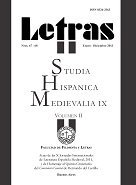El cuento de la doncella sin manos : versiones hispánicas medievales y la tradición oral en América
Keywords:
Folk Tale, Girl without Hands, Oral Tradition, Medieval LiteratureAbstract
From the first vernacular literary version of “The Girl Without Hands”, by Philippe de Remi in the thirteenth century, medieval literature has constantly reworked the tale along and across Western Europe. The period beginning on the thirteenth to the seventeenth century has given us, at least, thirty-four written versions in the Roman and Germanic regions. There is also an Arabic tradition of the story, probably of Semitic origin, which would constitute, according to some authors, an independent branch of the tale. In oral tradition it has survived in several countries including South America, particularly Brazil, Chile and Argentina. The folk heritage in Europe, originally collected by the Grimm brothers in 1812, has many common features with American versions. However, it has established a closer link between them and the Spanish folk tales collected by Aurelio Espinosa in 1923, as well as one of the three versions from the Arabic tradition. After drawing a historical overview of the corpus and studying the points of contact between European and American traditions, we focus on the analysis of the South American versions, particularly those collected in ArgentinaDownloads
Download data is not yet available.
Downloads
Published
2019-04-23
How to Cite
Basarte, A. (2019). El cuento de la doncella sin manos : versiones hispánicas medievales y la tradición oral en América. Letras, (67-68), 27–38. Retrieved from http://649820.fgwnw.asia/index.php/LET/article/view/1790
Issue
Section
Ponencias
License












